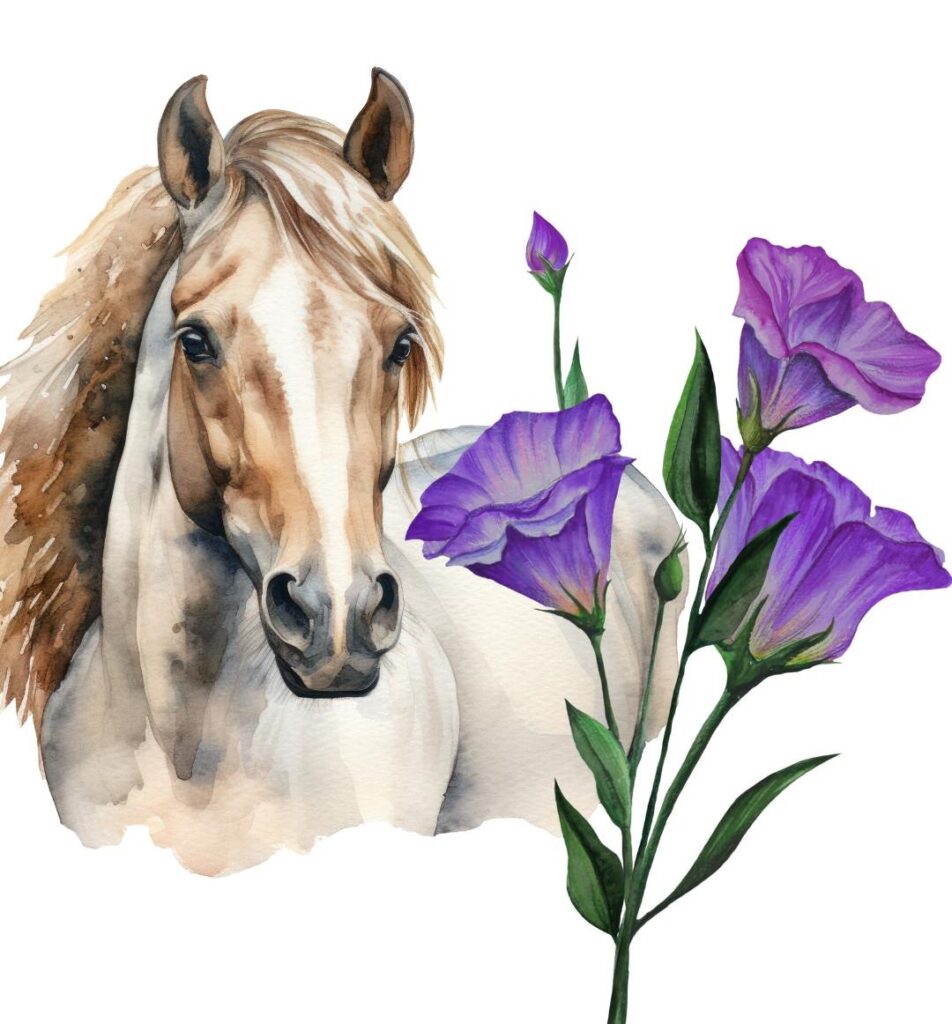Good bless Canva. Where else can an amateur graphic designer who sees something in her head while writing a newsletter article bring a wild mustang and a stem of lisianthus into the same frame for the perfect illustration? Now that I have your attention with a lovely visual aid, let’s dive into the history of lisianthus!
Lisianthus – or Eustoma grandiflorum if you prefer the Latin – began as a humble wildflower in America’s wild west. Its home range is the same as that of wild mustangs. Colorado, California, Wyoming, and New Mexico, to name a few. While I can’t prove it, I like to think of these two majestic species as being intertwined.
Lisianthus favor sandy soil along stream banks. They thrive in the blazing hot sun of the prairies and would spring up where the soil was disturbed. No doubt herds of wild horses (and bison) visited these streams on hot days. Those thudding hooves, stallions fighting, and young foals splashing around in the shallows no doubt primed both the soil and the seeds to birth a new generation of wild lisianthus each year.
Lisianthus haven’t been around as a cut flower for very long, compared to our other staples. It wasn’t until the early 1980s that a Japanese plant breeder took notice of our humble wildflower, which was originally purple, and started grooming it to become the beloved cut flower it is today. And even then it took several decades to get the genetics right and produce the rainbow of superstar varieties you love, like Corelli Light Pink, Blue Chateau, and Roseanne Green.

Because this beauty queen hailing from the prairies only recently stepped onto the floral stage, lisianthus is still somewhat unfamiliar to many retail consumers. This summer is a great time to build customer appreciation, especially during American Grown Flowers Month! Peak lisianthus season in our region is mid-July through mid-August with a smaller flush in October.
We could not have a better flower champion for these hot days from Hades! Lisianthus hold up to the worst of the heat, even out of water for hours… days even. Don’t judge, but I’ve been known to occasionally forget a bunch in the field after harvesting. They’ll lay out there on the brown grass in the blazing summer sun until the next morning when I’m harvesting again and find them, looking like nothing ever happened. Superhero flowers!
But like all superheroes (and wild mustangs), lisianthus can be brought to their knees by something. And that something is a super cold cooler. Lisianthus, lovers of sun and sand, don’t want to go into an ice box. To keep your lisianthus happiest in your shop or studio, either set your cooler to 40F or leave them out of the cooler altogether.
Also, don’t leave your lisianthus in sleeves. Like wild horses, they hate to be trapped. They need to breathe and move. As soon as you receive your bunches, unsleeve all lisianthus. At PFG, we use paper sleeves so this does allow them to breathe more than plastic, but it’s still wise to let them loose so their petals can unfurl fully and no disease builds up within their ruffles.
With this proper care, lisianthus can have a vase life of 21+ days! And each stem sold through PFG has at least three open blooms and several buds that will open in time, making for maximum value. Nothing will keep your customers coming back to you like locally-grown lisianthus!
Obviously I’m smitten with this All-American girl, Lisi. You’d be hard pressed to find a local flower farmer who isn’t. But I do still have one small wish for this native wildflower…Could one of those plant breeders make a ‘Black Beauty’, pretty please?
Yours truly,
Always A Horse-Obsessed Teenager At Heart

